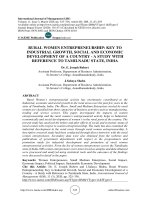Economic growth and economic development 176
Bạn đang xem bản rút gọn của tài liệu. Xem và tải ngay bản đầy đủ của tài liệu tại đây (139.04 KB, 1 trang )
Introduction to Modern Economic Growth
of the Malthusian channels discussed in Chapter 23 below. For example, we could
assume that
(4.2)
L (t) = φY (t) .
Combining these three equations, we obtain (see Exercise 4.1):
(4.3)
1
A˙ (t) = λφ 1−α A (t) .
The solution to this differential equation involves
³
´
1/(1−α)
(4.4)
A (t) = exp λφ
t A (0) .
This shows how a model of economies of scale (increasing returns) in population can
generate a steady increase in technology. It is also straightforward to verify that
(4.5)
α
Y (t) = φ 1−α A (t) ,
so that aggregate income also grows at the constant level λφ1/(1−α) . Such a model
would generate steady growth but no acceleration. Simon and Kremer, instead
assume that there are stronger externalities to population than in (4.1). They
impose the following equation governing the accumulation of ideas:
A˙ (t)
= λL (t) .
(4.6)
A (t)
This implies that the law of motion of technology is given by (see Exercise 4.2):
1
.
(4.7)
A (t) =
−1
A (0) − λφ1/(1−α) t
In contrast to (4.4), this equation implies an accelerating output level. Starting from
a low-level of A (0) (or L (0)), this model would generate a long period of low output,
followed by an acceleration or a take off, reminiscent to the modern economic growth
experience discussed in Chapter 1. Therefore, a model with significant economies of
scale is capable of generating the pattern of take off we see in the data
While such a story, which has been proposed by many economists, may have
some appeal for accounting for world growth, it is important to emphasize that it
has little to say about cross-country income differences or why modern economic
growth started in some countries (Western Europe) and not others (Asia, South
America, Africa). In fact, if we take Western Europe and Asia as the economic
units, European population has consistently been less than that of Asia over the
162









